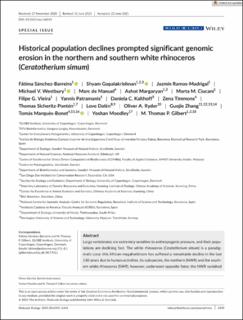Historical population declines prompted significant genomic erosion in the northern and southern white rhinoceros (Ceratotherium simum)
| dc.contributor.author | Sánchez-Barreiro, Fátima | |
| dc.contributor.author | Gopalakrishnan, Shyam | |
| dc.contributor.author | Ramos-Madrigal, Jazmín | |
| dc.contributor.author | Westbury, Michael V. | |
| dc.contributor.author | de Manuel, Marc | |
| dc.contributor.author | Margaryan, Ashot | |
| dc.contributor.author | Ciucani, Marta M. | |
| dc.contributor.author | Vieira, Filipe G. | |
| dc.contributor.author | Patramanis, Yannis | |
| dc.contributor.author | Kalthoff, Daniela C. | |
| dc.contributor.author | Timmons, Zena | |
| dc.contributor.author | Sicheritz-Pontén, Thomas | |
| dc.contributor.author | Dalén, Love | |
| dc.contributor.author | Ryder, Oliver A. | |
| dc.contributor.author | Zhang, Guojie | |
| dc.contributor.author | Marquès-Bonet, Tomás | |
| dc.contributor.author | Moodley, Yoshan | |
| dc.contributor.author | Gilbert, Marcus Thomas Pius | |
| dc.date.accessioned | 2022-03-25T11:53:00Z | |
| dc.date.available | 2022-03-25T11:53:00Z | |
| dc.date.created | 2022-01-04T15:03:31Z | |
| dc.date.issued | 2021 | |
| dc.identifier.citation | Molecular Ecology. 2021, 30 (23), 6355-6369. | en_US |
| dc.identifier.issn | 0962-1083 | |
| dc.identifier.uri | https://hdl.handle.net/11250/2987628 | |
| dc.description.abstract | Large vertebrates are extremely sensitive to anthropogenic pressure, and their populations are declining fast. The white rhinoceros (Ceratotherium simum) is a paradigmatic case: this African megaherbivore has suffered a remarkable decline in the last 150 years due to human activities. Its subspecies, the northern (NWR) and the southern white rhinoceros (SWR), however, underwent opposite fates: the NWR vanished quickly, while the SWR recovered after the severe decline. Such demographic events are predicted to have an erosive effect at the genomic level, linked to the extirpation of diversity, and increased genetic drift and inbreeding. However, there is little empirical data available to directly reconstruct the subtleties of such processes in light of distinct demographic histories. Therefore, we generated a whole-genome, temporal data set consisting of 52 resequenced white rhinoceros genomes, representing both subspecies at two time windows: before and during/after the bottleneck. Our data reveal previously unknown population structure within both subspecies, as well as quantifiable genomic erosion. Genome-wide heterozygosity decreased significantly by 10% in the NWR and 36% in the SWR, and inbreeding coefficients rose significantly by 11% and 39%, respectively. Despite the remarkable loss of genomic diversity and recent inbreeding it suffered, the only surviving subspecies, the SWR, does not show a significant accumulation of genetic load compared to its historical counterpart. Our data provide empirical support for predictions about the genomic consequences of shrinking populations, and our findings have the potential to inform the conservation efforts of the remaining white rhinoceroses. | en_US |
| dc.language.iso | eng | en_US |
| dc.publisher | Wiley | en_US |
| dc.rights | Navngivelse-Ikkekommersiell 4.0 Internasjonal | * |
| dc.rights.uri | http://creativecommons.org/licenses/by-nc/4.0/deed.no | * |
| dc.title | Historical population declines prompted significant genomic erosion in the northern and southern white rhinoceros (Ceratotherium simum) | en_US |
| dc.type | Journal article | en_US |
| dc.type | Peer reviewed | en_US |
| dc.description.version | publishedVersion | en_US |
| dc.source.pagenumber | 6355-6369 | en_US |
| dc.source.volume | 30 | en_US |
| dc.source.journal | Molecular Ecology | en_US |
| dc.source.issue | 23 | en_US |
| dc.identifier.doi | 10.1111/mec.16043 | |
| dc.identifier.cristin | 1974525 | |
| cristin.ispublished | true | |
| cristin.fulltext | original | |
| cristin.qualitycode | 2 |
Tilhørende fil(er)
Denne innførselen finnes i følgende samling(er)
-
Institutt for naturhistorie [1213]
-
Publikasjoner fra CRIStin - NTNU [37219]

